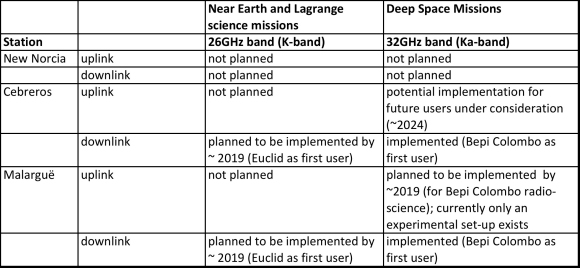Q&A
Answers provided by Luigi Colangeli (Head of the Coordination Office for the Scientific Programme) on 21 November 2014.
| Q1: |
In ESA documentation for the M4 call we found:
Today the M4 launch date is foreseen in 2025. At this time, Soyuz will be no more used in Europe and will be replaced by Ariane 6 that is not yet stabilized (we expect performances and cost improved since Soyuz). Moreover we know that Vega will be at least 20% more powerful than now in the Vega-C version in flight in 2017 (+300 kg at reference point, 700km / 90°). Can you agree to take into account the performances of Vega-C, 300kg above the reference point, 700km / 90° ? |
||||||||||||||||||||
| A1: | As explained to the proposers at the briefing meeting, the proposals should be built on existing launchers (thus take Soyuz if Vega as of today cannot do the job). Of course, the proposers are free to mention Vega-C option (as much as a passenger for lowering Soyuz launch cost in LEO or whatever option) and explain what would be the consequences. We do not perceive the Vega vs. Soyuz choice as a "making or breaking" case, nor as a crucial element for elaborating a winning mission proposal. Besides, the M4 deadline is anyhow beyond CMIN-14 and the corresponding decisions will be known. | ||||||||||||||||||||
| Q2: |
|
||||||||||||||||||||
| A2: |
The point was covered during the briefing meeting. The M4 call requires that the proposals give a description of the payload complement and identify teams/consortia interested and capable of providing the payload. This implies also a commitment (at the level expected for this selection phase) from Member States interested in supporting also this segment of the mission; letters of support from Member States are expected to be part of the proposals.
The support, at least for what can be considered the "core payload" to achieve the mission objectives, should be clear in the proposals. With this approach an AO at a later stage to select payload may be not needed if the commitment of the relevant partners for the main elements will be confirmed. Finally, the approach could be slightly different for missions where a few (1-2) big consortia are identified to provide the payload (typical of observatory-type missions) wrt missions requiring multi-payload complements (typical of planetary missions) and that various funding schemes could be proposed (see e.g., the GAIA management approach). |
||||||||||||||||||||
| Q3: | What is the cost for VEGA launcher? | ||||||||||||||||||||
| A3: |
The current cost estimates to be considered for the European launchers are:
|
||||||||||||||||||||
| Q4: | What is the approach with respect to participation of international partners to proposals? | ||||||||||||||||||||
| A4: |
The expected content of the letters of endorsement from potential international collaborators is clearly described in Section 3.4 of the Call. We have informed international partners of our approach for the M4 selection process and it is up to them to act as they think it is appropriate and possible. |
||||||||||||||||||||
| Q5: | Would it possible to have the Soyuz/Soyuz-Fregat performances provided in the M4 Call Annex (Fig. 8 and 9) in a table format? | ||||||||||||||||||||
| A5: |
Please find here [xlsx] the table relevant for the right part of Figure 9. The left part is simply the same information re-arranged differently, with C3=Vinf^2 in the x-axis.
For Figure 8, unfortunately we don't have the tabular version of the plot. This is a plot from Arianespace. |
||||||||||||||||||||
| Q6: |
|
||||||||||||||||||||
| A6: |
It is acceptable that the proposing team envisages an ESA contribution also in areas that usually are considered under the responsibility of the teams/consortia procuring the payload. ESA supported payload will be considered mission facility instrumentation. Please, note that for the items under responsibility of ESA clear interfaces and specifications (e.g. an electronics unit) have to be provided by the consortium and that the provider is selected by ESA through its usual process for selecting industrial contractors. |
||||||||||||||||||||
| Q7: | Up to 3 proposals will be selected for a study phase, but when will be the final selection among the three pre-selected mission projects? | ||||||||||||||||||||
| A7: | The number of selected proposals for study is TBC depending on received proposals and the final selection will depend on the kind of missions (e.g. for missions led by international partners the schedule would be driven by the schedule of the leading partner). | ||||||||||||||||||||
| Q8: | What is expected ESA timeline for the M4 mission phases A, B1, B2, C, D? | ||||||||||||||||||||
| A8: | TBC | ||||||||||||||||||||
| Q9: | Will there be possibility for new members to join payload consortia during the definition phase? | ||||||||||||||||||||
| A9: | Yes. Team organisation can be optimised at a later state. | ||||||||||||||||||||
| Q10: | Is there some guideline how big system margin one should apply and what are the numbers for design maturity margin to be used? | ||||||||||||||||||||
| A10: |
The following margins shall be considered:
The above figures are general guidelines and represent minimum mass margins to be considered. The Agency reserves the right to require additional margins if deemed necessary to cope with mission specific uncertainties. More detailed guidelines on the margin approach can be found in this document [pdf]. |
||||||||||||||||||||
| Q11: | What are the assumptions to be used for Ka-band stations - the cost and availability? | ||||||||||||||||||||
| A11: |
The ESA Deep Space Network is assumed capable to cope with M4 needs. The K-band capabilities are summarised in the following table. |
||||||||||||||||||||
